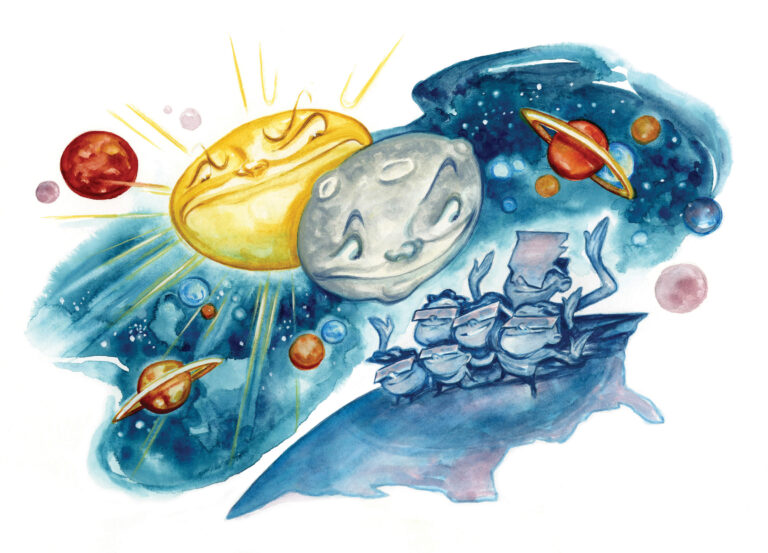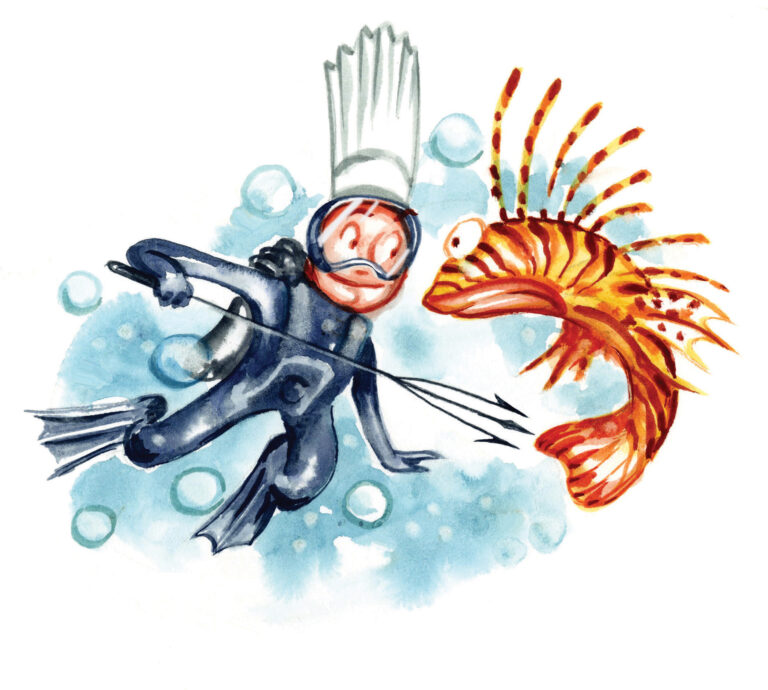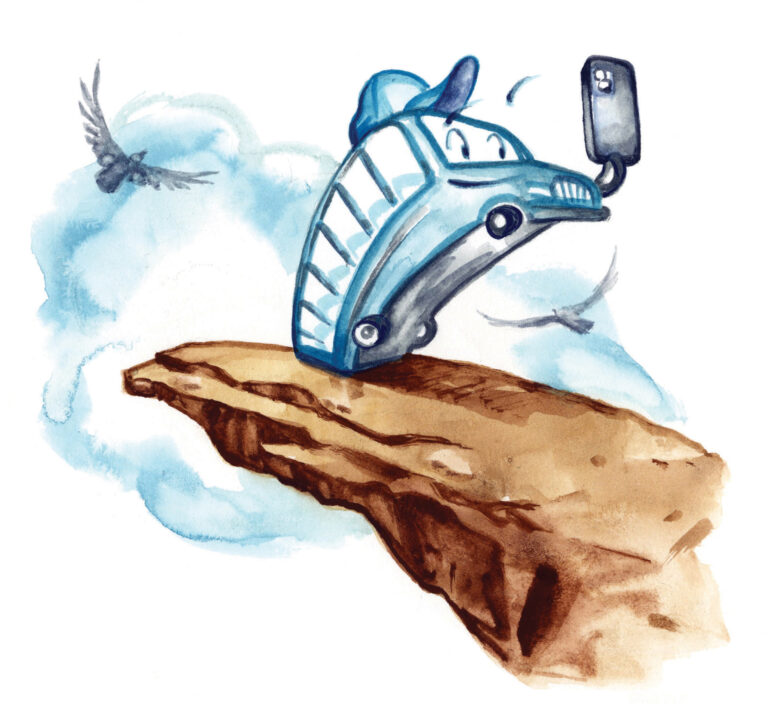by Susan B. Barnes, Jim Beaugez, Larry Bleiberg, Caroline Sanders Clements, Gabriela Gomez-Misserian, Jordan P. Hickey, Jennifer Kornegay, Lindsey Liles, T. Edward Nickens, Trudy Haywood Saunders, and Amy Brecount White
The More, the Merroir
“You can eat oysters 365 days a year,” says Anthony Ricciardone, who, as a co-owner of Admiral Shellfish Company on Mobile Bay, has a vested interest in dispelling the only-in-months-with-an-r myth. “April and May are honestly the sweet spot to visit down here to me.” Ricciardone farms oysters around historical Fort Morgan, and he worked with the Army Corps of Engineers, Coast Guard, various state agencies, and even archaeologists to secure a site that gets a daily push of clean, salty water. “If we’re gonna do this right,” he says, “and we’re gonna be in award-winning restaurants and let the product speak for itself, we’ve gotta pick the best water.” (Bon Secour Fisheries and Ahi Seafood Market in Fairhope keep Admiral’s oysters in stock for local buyers.) To coincide with the statewide Year of Alabama Food initiative, Ricciardone hosts group beachside walking tours of the oyster farm on Mondays and Thursdays, to orient people to the bounty of the Gulf Shores peninsula. “We aren’t allowed to actually shuck oysters and feed people, but we can point them at some local places to get them,” Ricciardone says. “And everybody goes home with a coozie.”

Total Eclipse of the Ark
“It’s going to be like Memorial Day weekend on steroids,” says Austin Albers, the president of the Buffalo Outdoor Center in Ponca. He’s referring to April 8’s total solar eclipse, when nearly two-thirds of the Natural State, including Little Rock, Hot Springs, and Jonesboro, will fall under the roughly 115-mile-wide sash of totality that extends from Mexico to Canada (in the States, from Texas clear up to Maine). By dint of cosmic coincidence, for this swath of the country, the humble April weekend has been injected with the chutzpah of a dozen public holidays. Arkansans began planning early, and the state has been rolling out the Razorback red carpet: Little Rock’s Lost Forty Brewing has crafted a helles bock dubbed Total AR’clipse of the Heart; at the Greene County Museum, staffers brought the sometimes-traveling Paragould meteorite to its home county for the first time in nearly a century; and thanks to twenty-seven state parks scattered across the totality, there’s no shortage of riverside, mountaintop, or tree-lined vistas from which to take it all in. Amid all the hubbub, however, it’s really just about that four-ish-minute window of moody daytime darkness that, for many folks, comes but once in a lifetime. And all you have to do is (cautiously) look up.

Catch and Relief
Not only do invasive and venomous lionfish compete with native reef fish for food, but the spiny bullies also routinely devour any other sea creature they can fit in their mouths. Lionfish reproduce quickly, and conservationists have been scheming ways to fight back for years. Destin–Fort Walton Beach, like other places in the Gulf as well as in the western Atlantic and Caribbean, has adopted a two-pronged solution: Catch them and eat them. To help protect coastal ecosystems, divers use spearguns and capture devices to trap lionfish and compete for prizes at the Emerald Coast Open (May 17 and 18), the world’s largest lionfish tournament. Last year’s catch? Nearly 25,000 fish, almost double the previous year’s haul. And during the ECO Restaurant Week (May 12–18), chefs serve up the sweet and mild fish. Last year’s restaurant-week winner, La Paz in Destin, served lionfish tostadas and fajitas, and even prepared it empapelado-style (in a foil pouch). “Don’t overcook it!” advises La Paz chef Felipe Isidoro. “Lionfish is very delicate, which is why steaming it empapelado-style works so well. Keep it simple and don’t overpower the fish.”
Chalk-a-Block
Nearly every spring in Savannah since 1980, artists have swapped paintbrushes for sticks of chalk and canvases for gray squares of sidewalk, transforming Forsyth Park into a living masterwork for Savannah College of Art and Design’s Sidewalk Arts Festival. This year marks the college’s forty-fifth anniversary, and the outdoor walking path will unspool into nearly eight hundred chalk artworks, as students and alumni blend and layer chalk on Saturday, April 27.

As locals and visitors weave through the historic park, musicians will take to stages and vendors will serve up food and cold, sweet treats. Meanwhile, students will create their transitory masterpieces. “It’s a day of immense joy and excitement,” says Kassidy Keenehan, a junior studying painting and drawing who received an award from the festival in 2022 for her chalk re-creation of William-Adolphe Bouguereau’s neoclassical painting L’Amour et Psyché, enfants. “It provides an opportunity for locals to engage with students and our artwork—the resounding encouragement from thousands of viewers fuels the creative expression.”

That expression won't come solely in the form of chalk. This year, keep an eye out for Abigail Tankersley, a 2022 fiber arts alumna who will install her own brightly colored sculpture by the Forsyth Park fountain.
Big Derby B-Day
May 4 brings the 150th running of the Kentucky Derby, a mint julep–soaked event that, incredibly, has never been canceled and has been postponed just twice. When World War II delayed the race in 1945, creative minds in Louisville took the fete in a different direction and introduced a turtle derby; the speedy-ish terrapin Broken Spring blazed to the finish line first. Jessica Whitehead, curator of collections for the Kentucky Derby Museum, says there were a few subsequent turtle races in the forties and fifties, and the sprint of slowpokes reappeared in 2020, when the pandemic postponed the iconic horse race. The museum’s latest exhibitions look back on all the stories, years of wild hats, and surprises—Long Shots highlights underdogs like Rich Strike, who roared into first place in 2022 at 80-1 odds, and Donerail, 1913’s champ, who still holds the record for the winner with the longest odds, at 91-1.
More Than Meets the Ear
The New Orleans Jazz & Heritage Festival (April 25–May 5) encompasses rock, blues, zydeco, and, of course, jazz, but there’s more than music to sing about. In the Louisiana Folklife Village, tradition-bearers demonstrate a wide spectrum of craftsmanship, including blacksmithing, quilting, float fashioning, and shrimp-net knitting. Janie Verret Luster has been weaving palmetto half-hitch baskets at the event since 1993; she rescued a technique that had been lost to her tribe, the United Houma Nation, and is passing it along, just as her ancestors did. “We were in Louisiana before many others, and we imparted knowledge, teaching newcomers to survive,” she says. “Now, all of us in the folklife tents love to share our cultures.” The sounds of creative camaraderie also strike a chord with Rachel Ornelas, the festival’s cultural heritage manager. “The fifth-generation plasterer is asking questions of the boatbuilder who’s talking to the stained-glass guy,” she says. “They’re swapping skills and stories, and they’re a real hoot, making the village the festival’s most magical spot.”
A Whole New Water World
Encased by asphalt and concrete, Baltimore’s Inner Harbor seems an unlikely spot to learn about nature. “It was always considered a place that was polluted, and if you fell in, something bad would have happened to you,” says Charmaine Dahlenburg, director of field conservation for the National Aquarium, which fronts the waterway. “We want to flip that narrative.” After more than a decade of prototyping, the institution will dedicate Harbor Wetland, a 10,000-square-foot floating habitat that replicates the tidal salt marsh once found in preindustrial Baltimore. The outdoor exhibit, which the aquarium likens to a giant buoyant Brillo pad, will be planted with nearly 40,000 plugs of cordgrass and native shrubs and should immediately begin to draw wildlife. Early models of the artificial island attracted turtles, crabs, snakes, migratory birds, and even a muskrat. A boardwalk spans the free exhibit, which shows just a glimpse of the Aquarium’s restoration projects throughout Maryland and Virginia. Dahlenburg says the postage stamp–size park also offers an unexpected urban escape. “You kind of forget you’re surrounded by buildings. It’s going to be a green space and a natural place, and as humans, we’re drawn to that.”
Three Chords and the Blues
The rise of the guitar in popular music traces back directly to Mississippi Delta sharecroppers like Robert Johnson and Mississippi John Hurt, who adopted the instrument in the early twentieth century. “Most music was based on horns or strings or keyboards, and the blues really gave the guitar its own identity,” says HP Newquist, a musician and author who founded the National Guitar Museum in 2008 (made up of touring exhibitions, it has no permanent location). This spring, through May 11, the Mississippi Arts and Entertainment Experience in Meridian will host the museum’s America at the Crossroads: The Guitar and a Changing Nation. The exhibition features dozens of guitars that tell the story of how the instrument shaped American music—including ones owned and played by Mississippi’s own musical icons Muddy Waters, B. B. King, Jimmy Buffett, John Lee Hooker, and Charley Pride, plus oddities like a 1930s “frying pan” Rickenbacker, the first commercially successful electric guitar.
Form and Function
When Nancy Strickland Fields looked at the flawless craftsmanship of an AD 700 pot discovered at Town Creek Indian Mound, she felt thunderstruck by inspiration for an exhibition she had been invited to guest-curate at the North Carolina Museum of Art. “I wanted it to focus on three-dimensional works that tell the story of who we are as Native peoples.” Over the next year and a half, Fields, a member of the Lumbee Tribe and the director of the Museum of the Southeast American Indian in Pembroke, gathered pieces from seventy-six Indigenous artists. The result—an exhibition titled To Take Shape and Meaning: Form and Design in Contemporary American Indian Art—runs through July 28 in Raleigh. Works include a beaded basket in the shape of an owl by the Passamaquoddy artist Jeremy Frey, Cherokee corn-husk dolls by Laura Walkingstick, and a piece by the Chickasaw Choctaw weaver Margaret Roach Wheeler. “For Native peoples, when we give something shape, we give it meaning and it takes on a life," Fields says. “This exhibition represents many different vibrant tribal nations from across the United States. The range of art from basketry to ceramics to mix media shows the commanding breadth of art from Native America....it is not only Native American art, it's American art.”

Singing Appraises
Between the world wars, the Charleston Renaissance saw the Holy City’s art scene flourish for the first time on a global stage. Half a century later, the launch of Spoleto, the city’s internationally revered arts festival, brought it back to a crescendo. If you ask Emily Grimball Longley, a Charleston native and a director at the newly opened Doyle auction house branch on King Street, the city is in the midst of a third revival. “Looking around, you can just see there’s a resurgence of interest in arts,” she says. The storefront welcomes potential sellers to have their heirlooms appraised and shoppers to preview national sales or peruse the silver and porcelain available for immediate purchase. The first auction house of its level to plant roots in the city, Doyle transcends region and era: You can find East Asian pottery alongside old master Dutch paintings and a pair of eighteenth-century French duck tureens. Stop in on April 9 to preview a national auction containing some of Doyle’s highest-valued jewelry, such as an emerald, ruby, and sapphire ring in the shape of an elephant. And in May, Doyle will collaborate with Spoleto to host the collection of the late, legendary Broadway composer Stephen Sondheim.
Tales from the Pit
“If you want to be the best, you have to beat the best, and this contest brings in the top pitmasters from all over the world,” says Josh Cooper, head chef for Swinos, a Memphis-based rib team and previous champions in the Beef, Sauce, and Exotic categories of the Memphis in May World Championship Barbecue Cooking Contest (May 15–18). “After cooking for five straight days, you need an IV, a vacation, and a detox,” Cooper says about the ongoing party at Liberty Park. His team of more than fifty rib savants knows the competition is intense, with teams vying for more than $150,000 in prize money and the title of world champion. Most pitmasters guard their secrets, but Cooper is willing to offer up one: “A great springtime ingredient is fennel—it pairs really well with pork.”
Pier Reviewed
It’s not walking on water, but it’s close. Moseying down the private pier at Rockport’s recently renovated Reel ’em Inn, guests can walk for a thousand yards over the Gulf of Mexico’s gentle waves. Custom benches and accent lighting give the pier a magical quality. Fishing for spotted sea trout, redfish, and black drum is stellar. Three young families recently finished a yearlong renovation on the 1950s-era motor court motel and pier, transforming them into a quiet retreat just south of Rockport’s bustling center. The renowned San Antonio–based architectural firm Lake Flato designed the nine rooms—four of which boast king-size beds and private waterfront cabanas—with a contemporary coastal feel, while accessories from Southern icons such as Turtlebox, Toadfish, and Duck Camp give the spaces a hip IYKYK vibe. “We’ve tried to bring a very modern look and feel to the place,” says James Reynolds, one of the revamped property’s owners, “while capturing all our great memories of old times on the Gulf.”

A View with More Room
McAfee Knob, the Appalachian Trail’s most photographed overlook, has long suffered from its own popularity. The trailhead parking lot fills early, creating traffic jams for day hikers eager to tackle the nearly eight-mile round trip to a stone ledge that—if you frame your picture just right—appears to hang over the lush Catawba Valley. “It looks very dangerous and dramatic, but it’s not really,” says Diana Christopulos, a past president of the Roanoke Appalachian Trail Club. She says the hardest part of the hike can be finding a place to park, and then dashing across a busy mountain highway blind spot to the path, one of the riskiest road crossings on the nearly 2,200-mile Georgia-to-Maine trailway. After years of complaints, Roanoke County has launched a trailhead shuttle that runs on a continuous loop from a park-and-ride in Salem, Friday to Sunday from March through November (and on holidays like Memorial Day). Transit planner Paula Benke says the changes are overdue: “People parked on both sides of the road. There was ticketing and towing.” But she understands McAfee’s appeal. “It sounds a little trite, but it is breathtaking.”
All Aflutter
When the Mountain State’s ephemeral wildflowers burst into bloom from March to May, they invite a special guest: the West Virginia white butterfly. Not to be confused with the common cabbage white, this fifty-cent-piece-size woodland butterfly with cream-white wings veined with smoky gray emerges just once a year. “There’s a lot happening for this species in the course of roughly a month,” says Jakob Goldner, a conservation entomologist with the West Virginia Division of Natural Resources. “The adults have to emerge, feed on nectar, mate, lay eggs, and then the caterpillars have to hatch, grow, and then create their chrysalises before their host plants die.” Then, the insect remains in the chrysalis, tucked into leaf litter on the forest floor, until next spring. The butterfly faces many threats: invasive garlic mustard, which resembles good host plants like toothworts but is toxic to the caterpillars, forest fragmentation, climate change, and overgrazing by deer. But for now, populations are still holding out in the Monongahela National Forest in the Allegheny Mountains and Kanawha State Forest—look for a flash of white fluttering at knee-to-waist height among spring wildflowers, like cutleaf toothwort.


